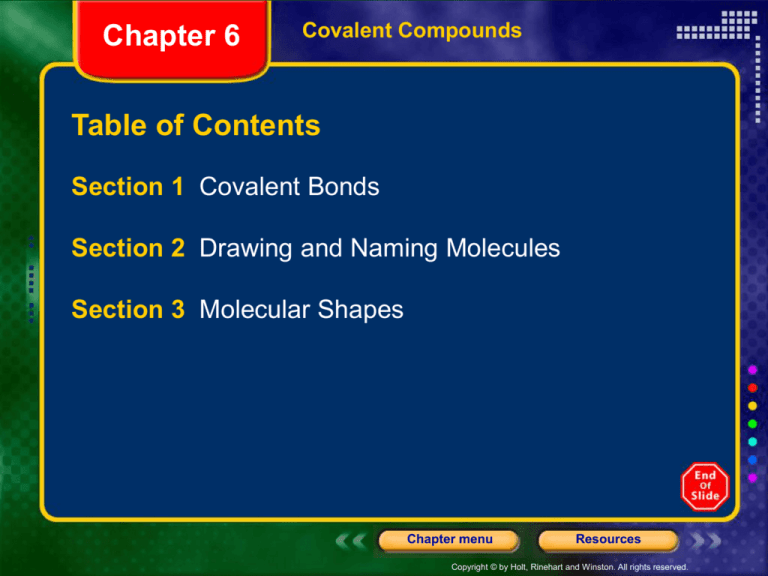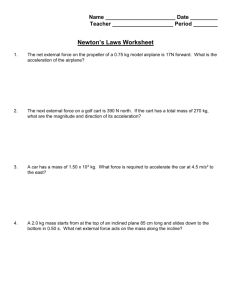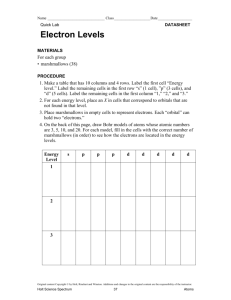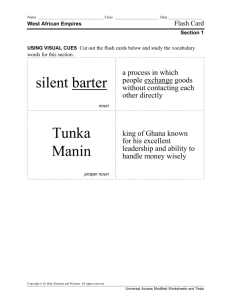
Chapter 6
Covalent Compounds
Table of Contents
Section 1 Covalent Bonds
Section 2 Drawing and Naming Molecules
Section 3 Molecular Shapes
Chapter menu
Resources
Copyright © by Holt, Rinehart and Winston. All rights reserved.
Chapter 6
Section 1 Covalent Bonds
Bellringer
• Make a list of the elements that form ionic bonds.
Note that most ionic bonds contain a metal and a
nonmetal.
Chapter menu
Resources
Copyright © by Holt, Rinehart and Winston. All rights reserved.
Chapter 6
Section 1 Covalent Bonds
Objectives
• Explain the role and location of electrons in a
covalent bond.
• Describe the change in energy and stability that
takes place as a covalent bond forms.
• Distinguish between nonpolar and polar covalent
bonds based on electronegativity differences.
Chapter menu
Resources
Copyright © by Holt, Rinehart and Winston. All rights reserved.
Chapter 6
Section 1 Covalent Bonds
Objectives, continued
• Compare the physical properties of substances that
have different bond types, and relate bond types to
electronegativity differences.
Chapter menu
Resources
Copyright © by Holt, Rinehart and Winston. All rights reserved.
Chapter 6
Section 1 Covalent Bonds
Sharing Electrons
• When an ionic bond forms, electrons are rearranged
and are transferred from one atom to another to form
charged ions.
• In another kind of change involving electrons, the
neutral atoms share electrons.
Chapter menu
Resources
Copyright © by Holt, Rinehart and Winston. All rights reserved.
Chapter 6
Section 1 Covalent Bonds
Sharing Electrons, continued
Forming Molecular Orbitals
• A covalent bond is a bond formed when atoms
_______________one or more pairs of electrons.
• The shared electrons move within a space called a
molecular orbital.
• A molecular orbital is the ______________of high
probability that is occupied by an individual electron
as it travels with a wavelike motion in the threedimensional space around one of two or more
associated nuclei.
Chapter menu
Resources
Copyright © by Holt, Rinehart and Winston. All rights reserved.
Chapter 6
Formation of a Covalent Bond
Chapter menu
Resources
Copyright © by Holt, Rinehart and Winston. All rights reserved.
Chapter 6
Visual Concepts
Chemical Bond
Chapter menu
Resources
Copyright © by Holt, Rinehart and Winston. All rights reserved.
Chapter 6
Section 1 Covalent Bonds
Energy and Stability
Energy Is Released When Atoms Form a Covalent Bond
Chapter menu
Resources
Copyright © by Holt, Rinehart and Winston. All rights reserved.
Chapter 6
Section 1 Covalent Bonds
Energy and Stability, continued
Potential Energy Determines Bond Length
• When two bonded hydrogen atoms are at their lowest
potential energy, the distance between them is 75 pm.
• The ___________________is the distance between
two bonded atoms at their minimum potential energy.
• However, the two nuclei in a covalent bond vibrate back
and forth. The bond length is thus the average
______________________between the two nuclei.
Chapter menu
Resources
Copyright © by Holt, Rinehart and Winston. All rights reserved.
Chapter 6
Visual Concepts
Bond Length
Chapter menu
Resources
Copyright © by Holt, Rinehart and Winston. All rights reserved.
Chapter 6
Section 1 Covalent Bonds
Energy and Stability, continued
Bonded Atoms Vibrate, and Bonds Vary in Strength
• The bond length is the average distance between two
nuclei in a covalent bond.
• At a bond length of 75 pm, the potential energy of H2 is
–436 kJ/mol.
• Thus 436 kJ of energy must be supplied to break the
bonds in 1 mol of H2 molecules.
• The energy required to break a bond between two
atoms is the _________________________.
• Bonds that have the higher bond energies
(stronger bonds) have the shorter bond lengths.
Chapter menu
Resources
Copyright © by Holt, Rinehart and Winston. All rights reserved.
Chapter 6
Section 1 Covalent Bonds
Electronegativity and Covalent Bonding
• In covalent bonds between two different atoms, the
atoms often have different attractions for shared
electrons.
• Electronegativity values are a useful tool to predict
what kind of bond will form.
Chapter menu
Resources
Copyright © by Holt, Rinehart and Winston. All rights reserved.
Chapter 6
Visual Concepts
Electronegativity
Chapter menu
Resources
Copyright © by Holt, Rinehart and Winston. All rights reserved.
Chapter 6
Section 1 Covalent Bonds
Electronegativity and Covalent Bonding,
continued
Atoms Share Electrons Equally or Unequally
• When the electronegativity values of two bonding
atoms are similar, bonding electrons are shared
equally.
• A covalent bond in which the bonding electrons in the
molecular orbital are shared equally is a
_________________________covalent bond.
Chapter menu
Resources
Copyright © by Holt, Rinehart and Winston. All rights reserved.
Chapter 6
Section 1 Covalent Bonds
Electronegativity and Covalent Bonding,
continued
Atoms Share Electrons Equally or Unequally,
continued
• When the electronegativity values of two bonding
atoms are different, bonding electrons are shared
unequally.
• A covalent bond in which the bonding electrons in the
molecular orbital are shared unequally is a
_______________________covalent bond.
Chapter menu
Resources
Copyright © by Holt, Rinehart and Winston. All rights reserved.
Chapter 6
Predicting Bond Character from
Electronegativity Differences
Chapter menu
Resources
Copyright © by Holt, Rinehart and Winston. All rights reserved.
Chapter 6
Section 1 Covalent Bonds
Electronegativity and Covalent Bonding,
continued
Polar Molecules Have Positive and Negative Ends
• In a polar covalent bond, the ends of the bond have
opposite partial charges.
• A molecule in which one end has a partial positive
charge and the other end has a partial negative charge
is called a ________________________.
• In a polar covalent bond, the shared pair of electrons is
not transferred completely. Instead, it is more likely to be
found near the more electronegative atom.
Chapter menu
Resources
Copyright © by Holt, Rinehart and Winston. All rights reserved.
Chapter 6
Section 1 Covalent Bonds
Electronegativity and Covalent Bonding,
continued
Polar Molecules Have Positive and Negative Ends,
continued
• The symbol is used to mean partial.
• + is used to show a partial _______________charge
• – is used to show a partial _______________charge
• example: H+F–
• Because the F atom has a partial negative charge, the
electron pair is more likely to be found nearer to the
fluorine atom
Chapter menu
Resources
Copyright © by Holt, Rinehart and Winston. All rights reserved.
Chapter 6
Visual Concepts
Comparing Polar and Nonpolar Covalent
Bonds
Chapter menu
Resources
Copyright © by Holt, Rinehart and Winston. All rights reserved.
Chapter 6
Section 1 Covalent Bonds
Polarity Is Related to Bond Strength
• In general, the greater the electronegativity difference,
the greater the polarity and the stronger the bond.
Chapter menu
Resources
Copyright © by Holt, Rinehart and Winston. All rights reserved.
Chapter 6
Section 1 Covalent Bonds
Electronegativity and Bond Types
• Differences in electronegativity values provide one
model that can tell you which type of bond two atoms
will form.
• Another general rule states:
• A covalent bond forms between two _______________.
• An ionic bond forms between a _______________and a
__________________.
Chapter menu
Resources
Copyright © by Holt, Rinehart and Winston. All rights reserved.
Chapter 6
Section 1 Covalent Bonds
Properties of Substances Depend on Bond
Type
• The type of __________that forms (metallic, ionic, or
covalent) determines the properties of the substance.
• The difference in the strength of attraction between
the basic units of ionic and covalent substances
causes these types of substances to have different
properties.
Chapter menu
Resources
Copyright © by Holt, Rinehart and Winston. All rights reserved.
Chapter 6
Properties of Substances with Metallic, Ionic,
and Covalent Bonds
Chapter menu
Resources
Copyright © by Holt, Rinehart and Winston. All rights reserved.
Chapter 6
Section 2 Drawing and Naming
Molecules
Bellringer
• Classify the following compounds according to the
type of bonds they contain:
• NO
• CO
• HF
• NaCl
• HBr
• NaI
Chapter menu
Resources
Copyright © by Holt, Rinehart and Winston. All rights reserved.
Chapter 6
Section 2 Drawing and Naming
Molecules
Objectives
• Draw Lewis structures to show the arrangement of
valence electrons among atoms in molecules and
polyatomic ions.
• Explain the differences between single, double, and
triple covalent bonds.
• Draw resonance structures for simple molecules and
polyatomic ions, and recognize when they are
required.
Chapter menu
Resources
Copyright © by Holt, Rinehart and Winston. All rights reserved.
Chapter 6
Section 2 Drawing and Naming
Molecules
Objectives, continued
• Name binary inorganic covalent compounds by using
prefixes, roots, and suffixes.
Chapter menu
Resources
Copyright © by Holt, Rinehart and Winston. All rights reserved.
Chapter 6
Section 2 Drawing and Naming
Molecules
Lewis Electron-Dot Structures
• _________________electrons are the electrons in
the outermost energy level of an atom.
• A _________________is a structural formula in which
valence electrons are represented by dots.
• In Lewis structures, dot pairs or dashes between two
atomic symbols represent pairs in covalent bonds.
Chapter menu
Resources
Copyright © by Holt, Rinehart and Winston. All rights reserved.
Chapter 6
Section 2 Drawing and Naming
Molecules
Lewis Electron-Dot Structures, continued
Lewis Structures Show Valence Electrons
• As you go from element to element across a period,
you add a dot to each side of the element’s symbol.
Chapter menu
Resources
Copyright © by Holt, Rinehart and Winston. All rights reserved.
Chapter 6
Section 2 Drawing and Naming
Molecules
Lewis Electron-Dot Structures, continued
Lewis Structures Show Valence Electrons, continued
• You do not begin to pair dots until all four sides of the
element’s symbol have a dot.
Chapter menu
Resources
Copyright © by Holt, Rinehart and Winston. All rights reserved.
Chapter 6
Section 2 Drawing and Naming
Molecules
Lewis Electron-Dot Structures, continued
Lewis Structures Show Valence Electrons, continued
• An element with an octet of valence electrons has a
stable configuration.
• The tendency of bonded atoms to have octets of
valence electrons is called the _______________rule.
Chapter menu
Resources
Copyright © by Holt, Rinehart and Winston. All rights reserved.
Chapter 6
Section 2 Drawing and Naming
Molecules
Lewis Electron-Dot Structures, continued
Lewis Structures Show Valence Electrons, continued
• When two chlorine atoms form a covalent bond, each
atom contributes one electron to a shared pair.
• An ____________________pair, or a lone pair, is a
nonbonding pair of electrons in the valence shell of an
atom.
Chapter menu
Resources
Copyright © by Holt, Rinehart and Winston. All rights reserved.
Chapter 6
Section 2 Drawing and Naming
Molecules
Lewis Electron-Dot Structures, continued
Lewis Structures Show Valence Electrons, continued
• A _______________bond is a covalent bond in which
two atoms share one pair of electrons
• The electrons can pair in any order. However, any
unpaired electrons are usually filled in to show how
they will form a covalent bond.
Chapter menu
Resources
Copyright © by Holt, Rinehart and Winston. All rights reserved.
Chapter 6
Section 2 Drawing and Naming
Molecules
Drawing Lewis Structures with Single Bonds
Sample Problem A
Draw a Lewis structure for CH3I.
Chapter menu
Resources
Copyright © by Holt, Rinehart and Winston. All rights reserved.
Chapter 6
Section 2 Drawing and Naming
Molecules
Drawing Lewis Structures for Polyatomic Ions
Sample Problem B
2SO
Draw a Lewis structure for the sulfate ion,
4 .
Chapter menu
Resources
Copyright © by Holt, Rinehart and Winston. All rights reserved.
Chapter 6
Section 2 Drawing and Naming
Molecules
Multiple Bonds
• For O2 to make an octet, each atom needs two more
electrons. The two atoms share four electrons.
• A _______________bond is a covalent bond in which
two atoms share two pairs of electrons.
Chapter menu
Resources
Copyright © by Holt, Rinehart and Winston. All rights reserved.
Chapter 6
Section 2 Drawing and Naming
Molecules
Multiple Bonds, continued
• For N2 to make an octet, each atom needs three more
electrons. The two atoms share six electrons.
• A _______________bond is a covalent bond in which
two atoms share three pairs of electrons.
Chapter menu
Resources
Copyright © by Holt, Rinehart and Winston. All rights reserved.
Chapter 6
Section 2 Drawing and Naming
Molecules
Drawing Lewis Structures with Multiple Bonds
Sample Problem C
Draw a Lewis structure for formaldehyde, CH2O.
Chapter menu
Resources
Copyright © by Holt, Rinehart and Winston. All rights reserved.
Chapter 6
Section 2 Drawing and Naming
Molecules
Resonance Structures
• Some molecules, such as ozone, O3, cannot be
represented by a single Lewis structure.
• When a molecule has two or more possible Lewis
structures, the two structures are called
_______________structures.
Chapter menu
Resources
Copyright © by Holt, Rinehart and Winston. All rights reserved.
Chapter 6
Section 2 Drawing and Naming
Molecules
Multiple Bonds, continued
Naming Covalent Compounds
• The first element named is usually the first one written
in the formula. It is usually the less-electronegative
element.
• The second element named has the ending -ide.
• Unlike the names for ionic compounds, the names for
covalent compounds must often distinguish between
two different molecules made of the same elements.
Chapter menu
Resources
Copyright © by Holt, Rinehart and Winston. All rights reserved.
Chapter 6
Section 2 Drawing and Naming
Molecules
Naming Covalent Compounds, continued
• This system of prefixes is used to show the number of
atoms of each element in the molecule.
Chapter menu
Resources
Copyright © by Holt, Rinehart and Winston. All rights reserved.
Chapter 6
Section 2 Drawing and Naming
Molecules
Naming Covalent Compounds, continued
• Prefixes can be used to show the numbers of each
type of atom in diphosphorus pentasulfide.
Chapter menu
Resources
Copyright © by Holt, Rinehart and Winston. All rights reserved.
Chapter 6
Visual Concepts
Naming Compounds Using Numerical Prefixes
Chapter menu
Resources
Copyright © by Holt, Rinehart and Winston. All rights reserved.









